The only way to get back in to the race was to drive perfect laps, something the best of drivers are rarely ever able to do. Both Hill and co-driver Bruce McLaren steadily improved their times, until Hill finally set a new lap record just after dawn. By the time the gearbox failed, the car was either in 3rd or 5th place, depending on what source you want to believe. Either way, the team of Hill and McLaren had given one of the greatest unrewarded efforts in motorsports history.
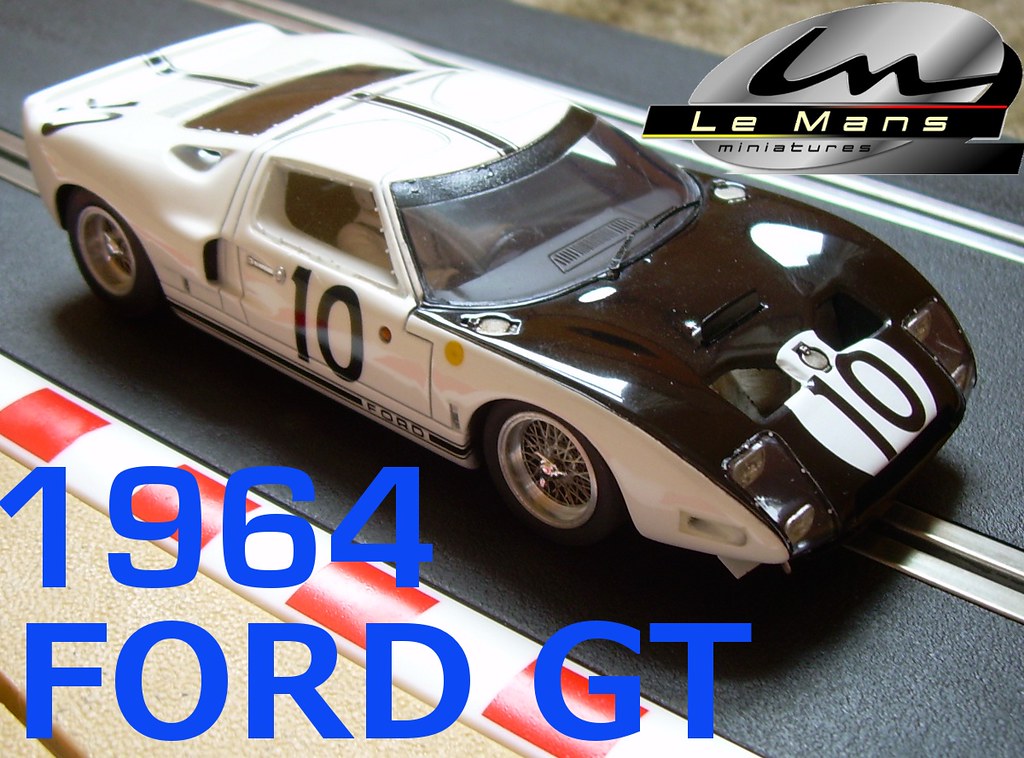
Le Mans Miniatures has modeled all three Ford GT's that entered and failed to finish Le Mans in 1964. They refer to this particular version as “lap record†in honor of Phil Hill's record run. Oddly enough, they chose to put Bruce McLaren behind the wheel!
Visually, LMM nailed the original Ford GT.


Since these cars were dismantled following the race, we only have to go off of scans of period photographs, and it looks like every detail that can be seen in these has been translated to the slot car. Outside of a little bit of rough spots on the paint in the stripe on the windshield, the overall finish of the car is superb.
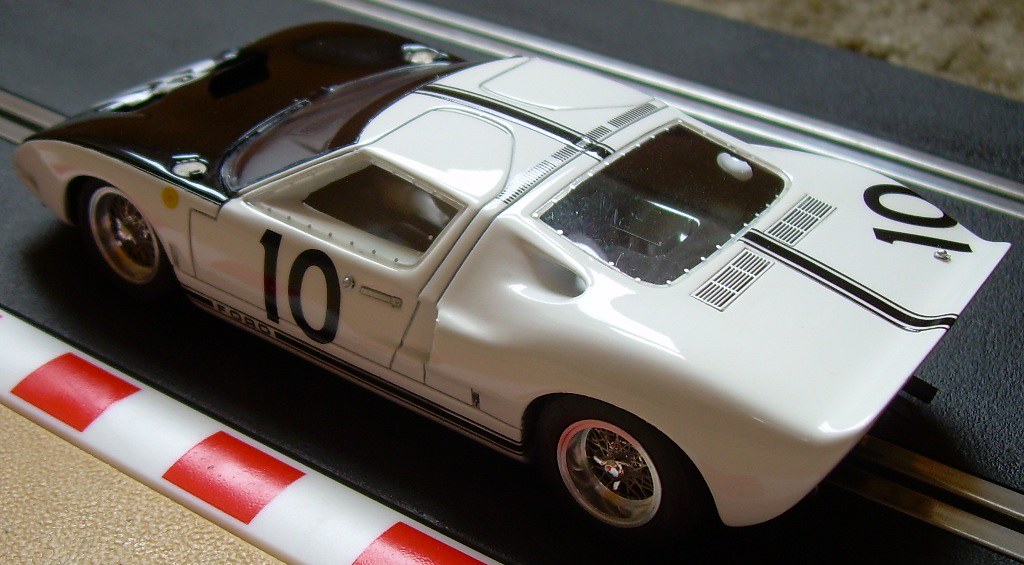
The interior is highly detailed, even sporting a decal representing the instruments on the dashboard that really can not be seen unless you remove the whole thing.

And removing the interior is not hard since it's not attached. Yep, it just gets sandwiched in place between the body and the chassis. I tried running the car with and without it in place. Since I couldn't hear any additional rattling when it was in there, I'm guessing that this odd gamble of not affixing it to either the body or chassis actually works.
The wheels are steel with accurate photo-etched wire spoke inserts.
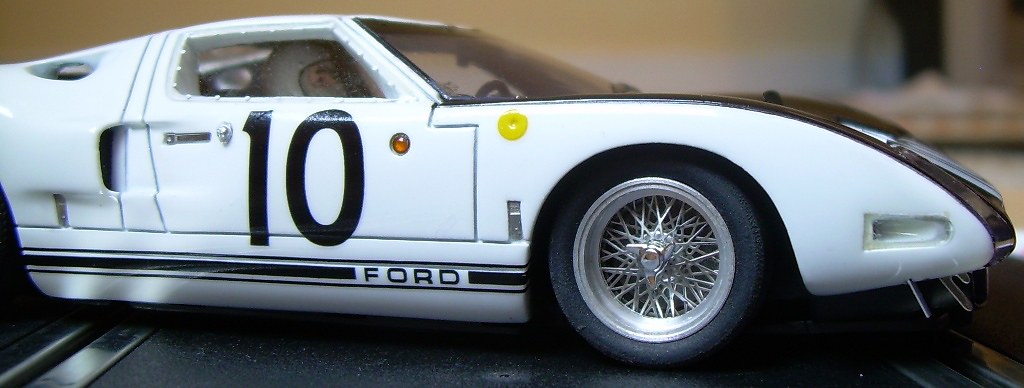
LMM advertises that the knock-offs on each side of the car are different, and indeed they are. While a nice touch, it's not a make or break detail for me when it came to deciding to buy this car. As nice as this car looks, I wish they would have put a little effort in to making sure that it could move under its own power.
To that end, they've gone the Racer route and enlisted Slot.it to supply their running gear. Those items bearing the Slot.it name include:
motor (red end bell)
motor pod
motor pod bushings (they look more like donuts than standard slot car bushings)
lead wires
guide
pinion
spur
I can't tell if the axles or even the chassis itself are Slot.it. The chassis looks like it could support the variable front axle system where varying length set screws help determine ride height, however plastic bushings have been glued in which keep us from taking advantage of that feature.
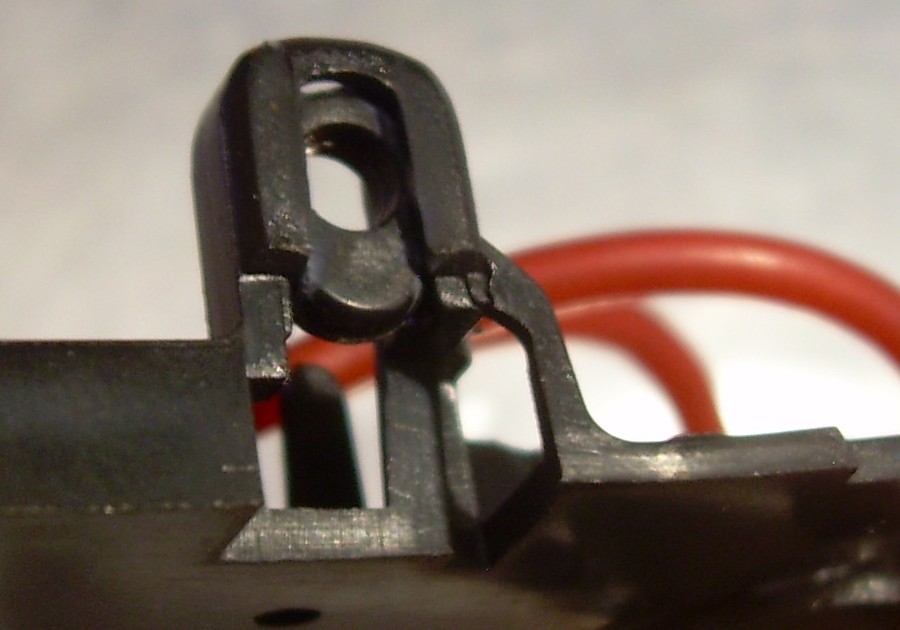
Try as I might, I could not dislodge them.
Starting at the front of the chassis, the guide is a Slot.it CH66, and sports the hardest braids that I've ever seen on a slot car. Bend them down and you've got an instant jack for your car. If you want this car as merely trackside scenery, bend them and go ahead and stick a Scalextric mechanic under it. You'd be all set. However, you may wish to swap them to softer braids if you plan to regularly run the car. The braids are held in and attached to the lead wires by set screws so the change is nice and painless.
The lead wires are routed above the axle, so they pinch pretty good with the body on, especially when the guide turns in either direction. I tried a couple of solutions to this problem.
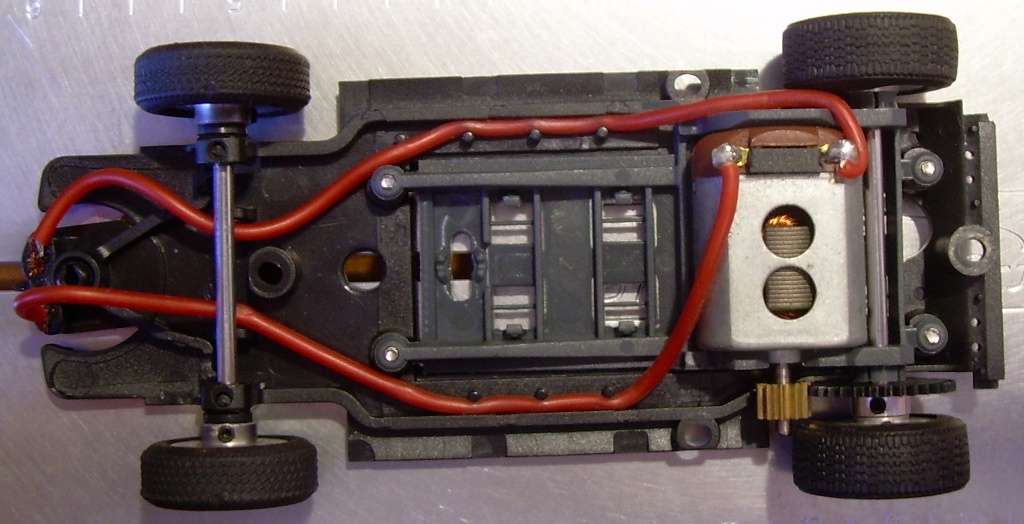
You could run them under the axle, but then there would still be friction.
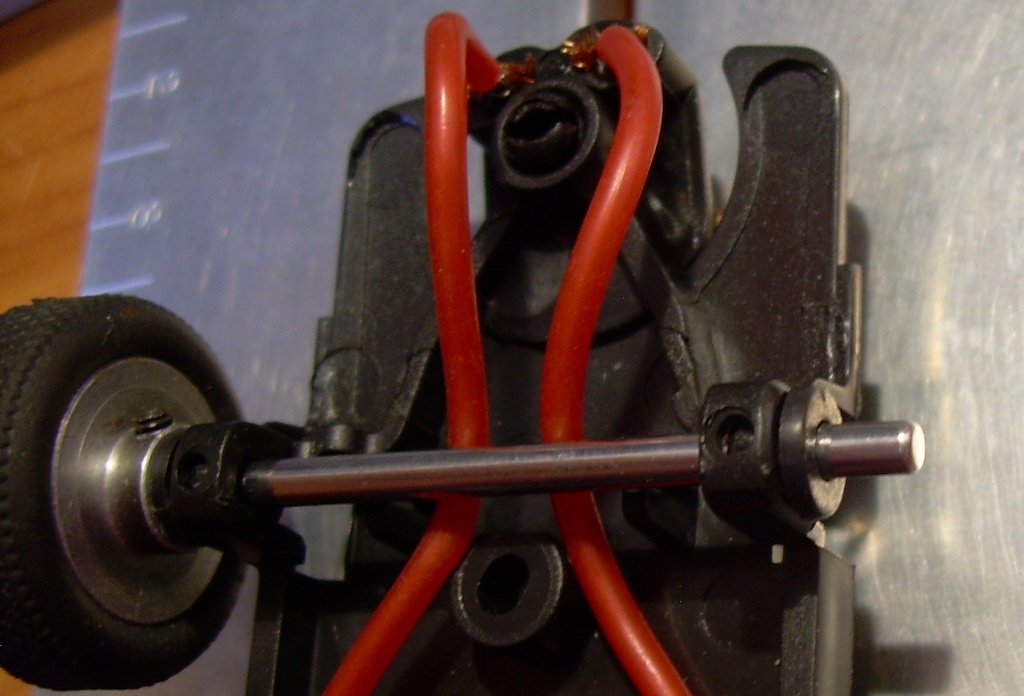
Another option is to route the wires through the front axle mounts. This is the cleanest looking solution, but the lack of slack in the wires means that the guide may not be able to turn from lock to lock.
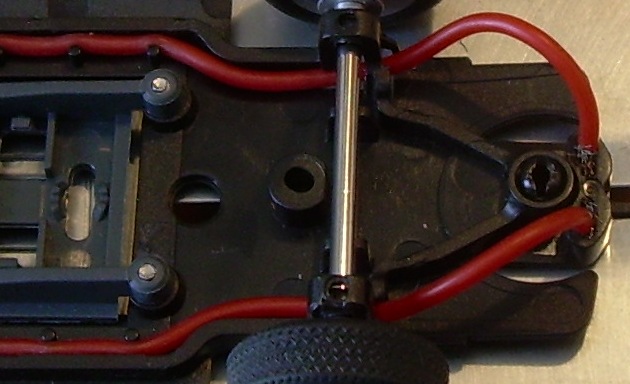
The third option is to utilize a portion of the adjustable front axle assembly and merely jam the wires in there, which is what I did. Since I'd never be able to use the adjustable feature anyway, this at least made having these things there worthwhile.

The motor pod has screws in four corners. I found that a significant amount of chatter was noticeable with the front two screws loose, so I've left them tight and backed off the rears a tad. The motor sits tight, but the option to add screws is there in case you want to make sure that it doesn't move. I noticed no movement, so left it as it was.
The spur was butt-up against the plastic of the motor mount, so I added an SCC axle spacer to give it some breathing room. I don't know if this made any difference at all, but it made me feel better. There are no regular bushings, instead there are little brass donuts recessed in to the mount.

So following those minor adjustments, it was off to the track where the car moved fairly well. There was chattering and the car was all over the place, but it was soon turning consistent if not adventurous laps. That is, until one of the rears fell off.

The wheels are interesting, or rather the set screws that hold them on were quite perplexing. For the first two days that I had the car, I was convinced that the set screw heads were an odd size. My regular 0.9mm driver just spun in the screws. It was trying to bite, but just kept slipping. Nearing the red-faced point of frustration, I finally just Hulked-out, pressed really hard, and I mean really hard, and the driver bit enough in all four screws that I was able to remove the wheels. The screws immediately found their way to my trashcan and some new SCC ones took their place. Also gone where two plastic axle spacers on the front axle, again replaced with more exact SCC goodies.
With the wheels now firmly in place, I decided to give the tires a sanding. Here is my state-of-the-art sanding station. That's some 220 grit paper, duct tape, a 9v, and a hunk of Jiada track.
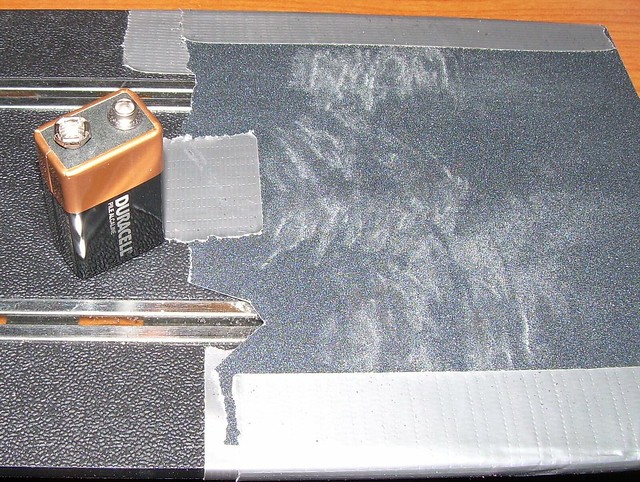
The car drove as though it were on ice, so I figured that removing the high treads may be a good idea. I began sanding. I don't know what these tires are made out of, but you could probably cut glass with them. After roughly an hour and no significant progress, I decided that there were better ways to spend my time.
Several days later, I had another go. With both the rears and fronts now sanded, I thought I was done. But then the front wheels wouldn't spin. I don't know what I could have done to cause the wheels to lock up. I hadn't noticed this before, but they were certainly binding on the insides of the wheel wells. The body is fairly thin at that point, so dremeling some breathing room wasn't an option. So I sanded down the front wheels until they spun freely. This time, after almost three hours and two 9v batteries, the tires were finally spinning and smooth enough to have another attempt at driving on the track.
Whoa boy! The car drove like it was on rails. No other car that I own drove this straight. Occasionally, the tail would kick out in the turn and the car would get stuck, unable to straighten out no matter how much juice it received. After searching for a bit, it was obvious that the car wasn't running straight because it was perfectly tuned, but because the guide itself could not move. When enough force was given, say that of entering a turn too hot, then the guide would turn and become locked against the bottom of the body's nose.
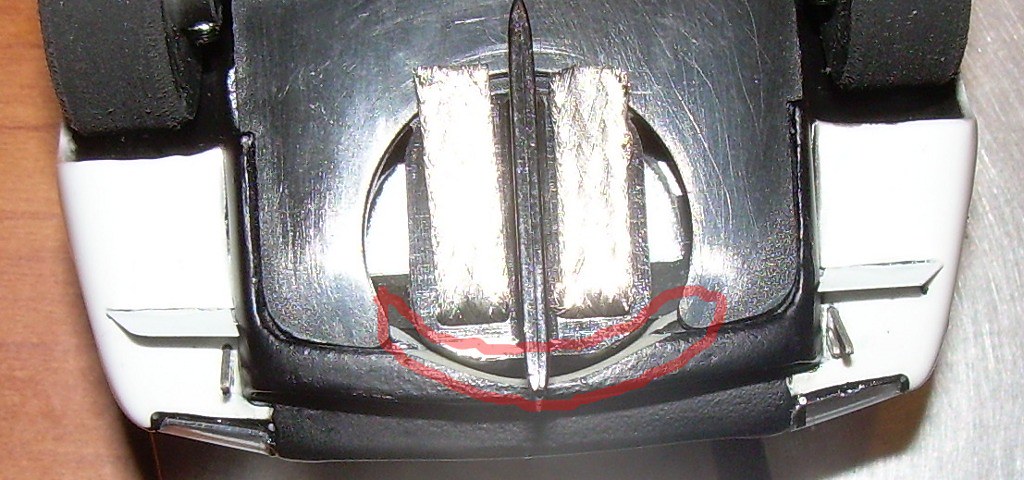
After sanding by hand, careful not to sand too much as there are scoops molded in to the front of where the guide was binding, there was finally enough room for everything to move as it should. So, back to the track...
And what a difference all of the labor had made. The car is a joy to drive. The whir of the sidewinder gears offers a complimentary melody to the sight of the Ford hugging corners and rocketing down straights. After what amounted to weeks of on and off frustration, here is a car that's movement on the track can best be described as addicting.

So, was it worth it? To me, yes. I love the history of the Ford Le Mans successes and failures, and this is a version of the GT that is only available either through LMM or antique and not nearly as accurate Strombecker and Eldon releases.
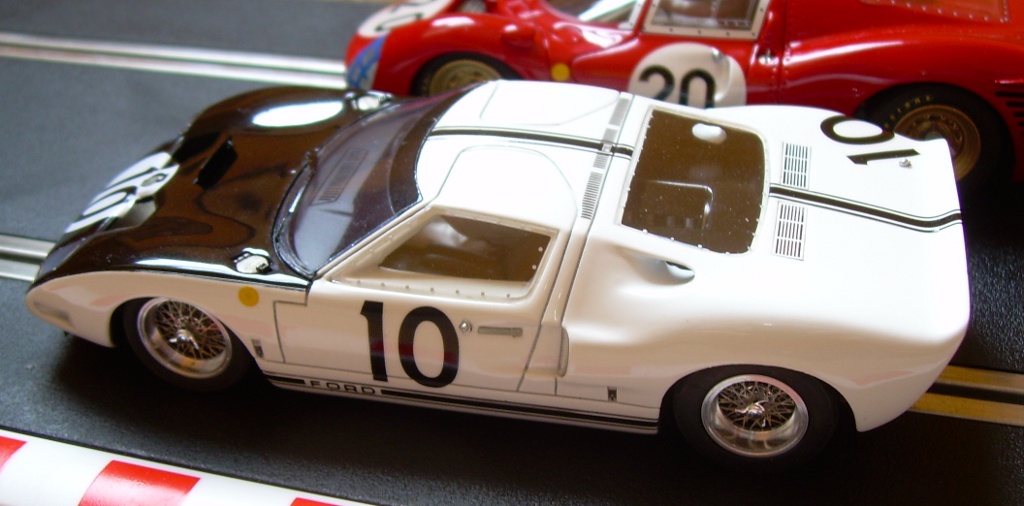
The take-away from this saga is that just because Le Mans Miniatures advertises that certain models are “powered by Slot.it,†that does not mean that the models are ready from the box to travel smoothly around your track. What it does mean is that the majority of the tuning components that you will require are already installed. These LMM/Slot.it releases are a great jumping-off point for what can become a fantastic running car, but they certainly require patience and commitment to get there.
